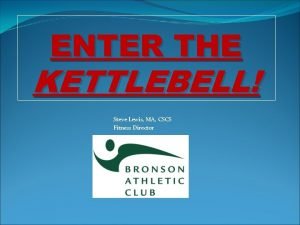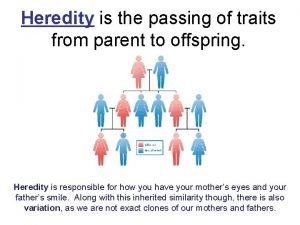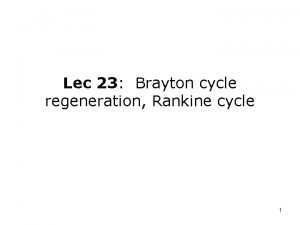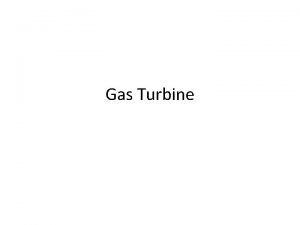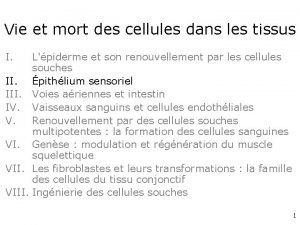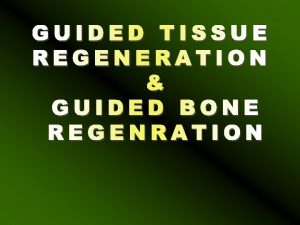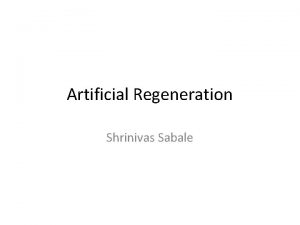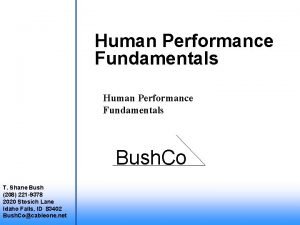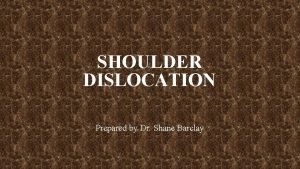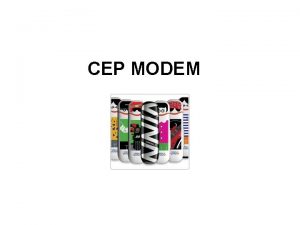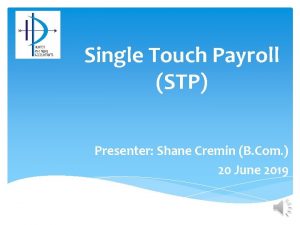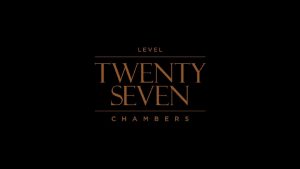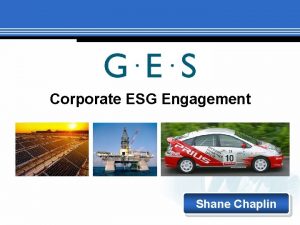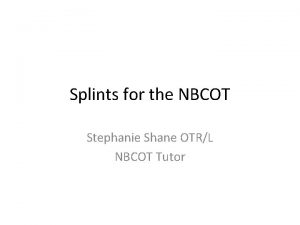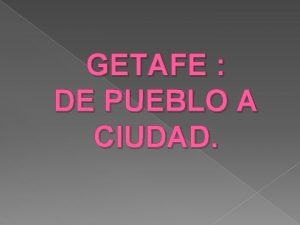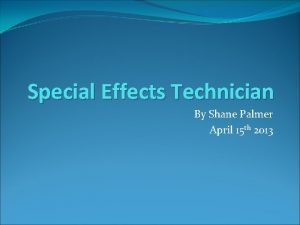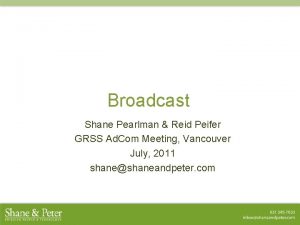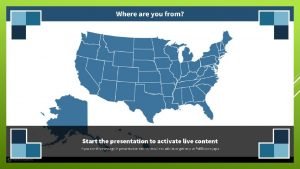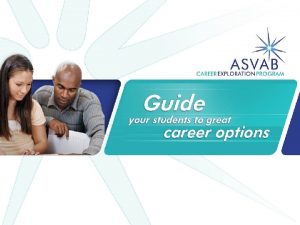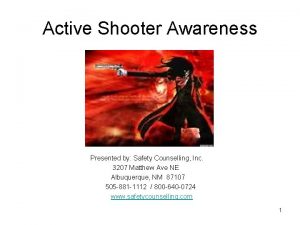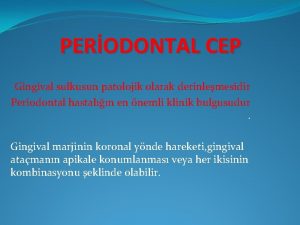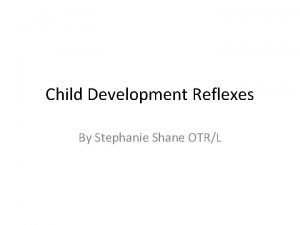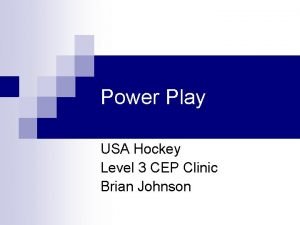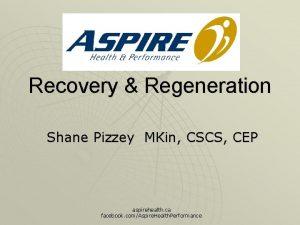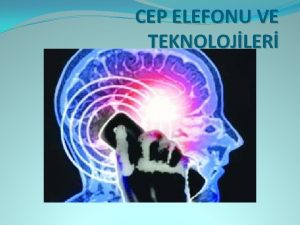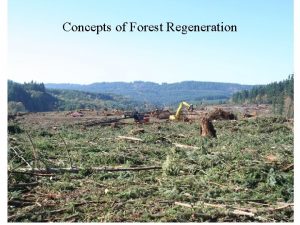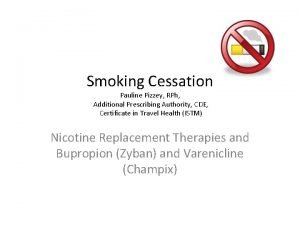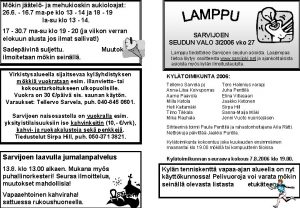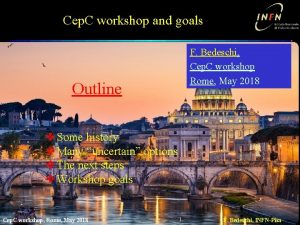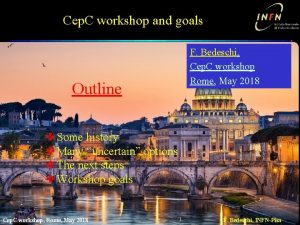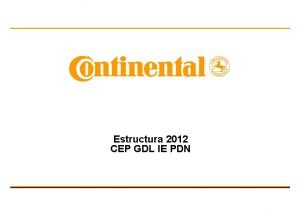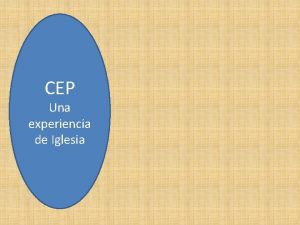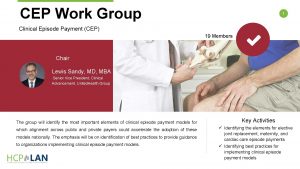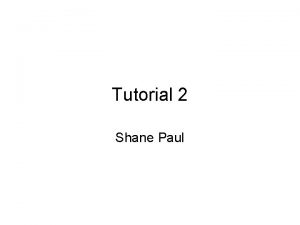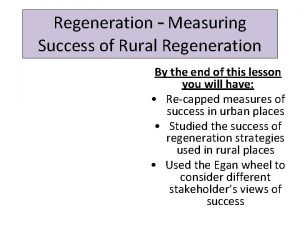Recovery Regeneration Shane Pizzey MKin CSCS CEP pinnacleelite








































- Slides: 40

Recovery & Regeneration Shane Pizzey MKin, CSCS, CEP pinnacleelite. com facebook. com/pinnalceeliteathlete

Quotes ‘Recovery…. that’s the name of the game…. . Whoever recovers the fastest does the best’ Lance Armstrong. ‘The hardest thing for an athlete to do is not to train. You can’t sit still. You feel you should be out there working’ Graham Obree – World Champion Cyclist pinnacleelite. com facebook. com/pinnalceeliteathlete

Introduction u u There is a very fine line between being a World Champion athlete and an also ran athlete The key question is, how can you push yourself to the limits of human performance without tipping over the edge? How can you train hard without falling apart? The answer: one of the simplest yet most neglected training principles - RECOVERY pinnacleelite. com facebook. com/pinnalceeliteathlete

Definition Recovery: gradual healing (through rest) after sickness or injury u Regeneration: growth anew of lost tissue or destroyed parts or organs so that the original function is restored u pinnacleelite. com facebook. com/pinnalceeliteathlete

Progressive Overload u u u Training is designed to progressively overload the body systems and fuel stores If the training stress is inadequate to overload the physiological system then no adaptations will occur If the workload is too great (applied too quickly, performed too often without adequate rest) then fatigue follows and the following performance will be reduced Work alone is not enough to produce the best results. Your body needs time to adapt to training To encourage adaptation to training it is important to plan recovery activities that reduce residual fatigue The sooner you recover from fatigue and the fresher you are when you complete a training session, the better the chance of improving pinnacleelite. com facebook. com/pinnalceeliteathlete

Fitness vs. Fatigue pinnacleelite. com facebook. com/pinnalceeliteathlete Adapted from Grantham

Fitness vs. Fatigue u u If we present a recovery method at the point of fatigue we can expect to reduce the amount of time it will take for the athlete to recover from training The broken line represents the improved recovery rate The yellow shaded area represents the increased window of opportunity for the presentation of the next training stimulus We can then present another training stimulus sooner pinnacleelite. com facebook. com/pinnalceeliteathlete

Types of Fatigue is multi-factorial – depending on the type of training stimulus, an athlete can experience a number of different forms of fatigue u Before we can introduce a recovery strategy we need to know what type of fatigue we are dealing with u pinnacleelite. com facebook. com/pinnalceeliteathlete

Types of Fatigue u Metabolic Fatigue (energy stores) • • u High volume training Repeated workloads Aerobic/Anaerobic conditioning Multiple training sessions throughout day Tissue Damage • • • Plyometrics Eccentric loading Contact sports pinnacleelite. com facebook. com/pinnalceeliteathlete

Types of Fatigue u Neurological (peripheral nervous system) • High intensity work • Resistance training (strength and power development) • Speed work • Skill sessions and introduction of new training techniques pinnacleelite. com facebook. com/pinnalceeliteathlete

Types of Fatigue u Psychological (CNS & emotional fatigue) • • • u Training monotony Lifestyle issues Heavy game/competition/training period Pressure plays New training techniques Environmental • Hot and cold environments • Travel (local, national, international) • Time differences pinnacleelite. com facebook. com/pinnalceeliteathlete

Recovery Strategies Adapted from Grantham pinnacleelite. com facebook. com/pinnalceeliteathlete

Recovery Strategies u u You should NOT be considering Levels 3 & 4 recovery strategies if you have not even established the basics at Levels 1 & 2 Level 1 • Sleep/Rest (passive and active) Sleep is one of the most important forms of rest and provides time for the athlete to adapt to the physical and mental demands of training. u Other forms of passive rest include reading, listening to music u Other forms of active rest such as walking, cross training and stretching are also beneficial to an athletes overall recovery u pinnacleelite. com facebook. com/pinnalceeliteathlete

Recovery Strategies u Level 1 • Nutrition (refuelling and rehydration) The most important components for nutritional recovery are fluid and fuel replacement. You should avoid drinks containing caffeine and drink enough fluid (water or sports drinks) before, during and after training to replace sweat loss. u There is a 45 -minute window of opportunity for refuelling. The ideal recovery nutrition strategy is a meal or liquid supplement containing high glycaemic index carbohydrates and quality proteins in approximately a 4: 1 ratio u This includes 10 -20% if the athletes total daily caloric intake of these two macronutrients u pinnacleelite. com facebook. com/pinnalceeliteathlete

Recovery Strategies u Level 2 • Periodization u u One of the fundamental components of any training program An athlete’s ability to recover will be enhanced through the use of a well planned training program, which allows time to recover from the training that is being undertaken • Reactive Programming u u Once you have a plan (see Periodization), accept that there will be times when you need to deviate from it in order to recover! The ability for a coach and athlete to react to a given situation is crucial to the success of the program If the athlete is fatigued there is little point training for the sake of sticking to the program Athletes and coaches need to be able to program reactively pinnacleelite. com facebook. com/pinnalceeliteathlete

Recovery Strategies u Cool down and stretching • The cool down is a group of exercises performed immediately after training to provide a period of adjustment between exercise and rest. • Its purpose is to improve muscular relaxation, remove waste products, reduce muscular soreness and bring the cardiovascular system back to rest. • Stretching is often combined with the cool down. Many athletes lack sufficient flexibility to perform their sports movements efficiently and the elevated temperatures following exercise provide a good opportunity to improve ROM and reduce the risk of injuries pinnacleelite. com facebook. com/pinnalceeliteathlete

Recovery Strategies u Level 3 • Compression Skins This is the latest boom business in terms of recovery, and leading sports apparel manufacturers are producing garments with ‘compression qualities’ u Heavy training can cause muscle damage resulting in soreness, swelling, pain and impaired athletic performance (Kraemer) u Recent scientific research has indicated that external compression can be an effective treatment that minimizes swelling, improves the alignment and mobility of scar tissue and improves proprioception in an injured joint following eccentric damage and DOMS u pinnacleelite. com facebook. com/pinnalceeliteathlete

Recovery Strategies u Level 3 • Massage u The idea behind massage is that it can have the following impact: • Physiological benefits: u 1. Increased blood flow, enhanced oxygen and nutrient delivery to fatigued muscles, increased removal of lactic acid u 2. Warming and stretching of soft tissues increasing flexibility, removal of micro trauma, knots and adhesions • Psychological benefits: u 1. Improved mood state u 2. Increased relaxation and feeling less fatigued u u Massage also improves an athlete’s body awareness – which muscles have been stressed Athletes should spend 10 minutes at the end of a training day performing some self massage (particularly legs and shoulders) pinnacleelite. com facebook. com/pinnalceeliteathlete

Recovery Strategies u Level 3 • Contrast Showers u u Alternating hot and cold showers/baths provides an increase in blood flow to the working muscles and accelerates the removal of lactic acid Contrast showering also stimulates the nervous system because the brain has to receive and recognize two different types of information (hot and cold). The changes in temperature also help to increase arousal • Guidelines: u u u u Complete within 30 minutes of training/competition Hot - 35 -40ºC Cold 10 -15ºC Shower – hot 1 -2 mins, cold 30 -60 secs (repeat 3 -4 times) Bath/Spa – hot 3 -4 mins, cold 30 -60 secs (repeat 3 -4 times) Bath – cold 30 -60 seconds immersion, followed by 60 seconds dry rub (vigorously rub the cooled areas) with a towel (repeat 2 -4 times) Begin and end with cold pinnacleelite. com facebook. com/pinnalceeliteathlete

Recovery Strategies u Level 3 • Cold Baths u Cold baths have primarily been used for their pain relieving properties u Rationale is that when you plunge your body into a bath full of icy cold water vasoconstriction occurs and the blood will be drained away from the muscles that have been working (removing lactic acid) u Once you get out of the bath the capillaries dilate, ‘new’ blood flows back to the muscles bringing with it oxygen that will help the functioning of the cells u Recent research by Sam Erith at Loughborough University has shown that treatment with cryotherapy improves muscle function, reduces muscle damage and decreases soreness associated with DOMS • Guidelines: u Cold 5 -15ºC u Duration 7 -10 minutes to cool the muscles (shorter if looking for short term pain relief) u Keep the body parts moving to prevent a ‘barrier’ of warm water forming around the limbs. pinnacleelite. com facebook. com/pinnalceeliteathlete

Matching Fatigue & Recovery Strategy u Metabolic Fatigue & Tissue Damage • Sleep, rest (passive and active) • Nutrition • Hydrotherapies (contrast showers) • Massage • Compression clothing pinnacleelite. com facebook. com/pinnalceeliteathlete

Matching Fatigue & Recovery Strategy u Neurological (peripheral nervous system) • • • u Sleep, rest (passive and active) Hydrotherapies (cold baths) Massage Psychological(CNS and emotional fatigue) • • • Sleep, rest (passive and active) Meditation Counseling pinnacleelite. com facebook. com/pinnalceeliteathlete

Matching Fatigue & Recovery Strategy u Environmental • Sleep, rest (passive and active) • Hydrotherapies (contrast bathing, cold baths) pinnacleelite. com facebook. com/pinnalceeliteathlete

Self Myofascial Release u Most popular method is the Foam Roller • Available in many densities u u Other methods include “The Stick”, various balls and other commercial products Rationale • Muscles need to be lengthened • Muscles develop “knots” • Muscles need to be pliable pinnacleelite. com facebook. com/pinnalceeliteathlete

Self Myofascial Release u Science behind • Autogenic Inhibition Pressure place on the GTO at the tendons sends a signal to the muscles to relax u While the muscle is relaxed, we can more easily create the change in length and tone u • Better than stretching? While stretching no doubt helps to increase length of muscle fibres, it does not decrease muscle tone and increase pliability u SMR can also break up soft tissue adhesions and scar tissue u pinnacleelite. com facebook. com/pinnalceeliteathlete

Self Myofascial Release u Tools • Foam Roller A foam roller is the largest implement we would use from a pressure perspective u The foam roller is very versatile, as you can work almost every muscle group using a foam roller alone u Rollers also come in varying densities, which allows for progression as well u pinnacleelite. com facebook. com/pinnalceeliteathlete

Self Myofascial Release u Tools • Medicine Ball While not as popular as the foam roller, the medicine ball may actually be a more versatile tool for SMR purposes u Not only is it more focal when compared to the roller (the surface area being worked is smaller, which increases pressure), but it also allows you to work in a more threedimensional fashion u pinnacleelite. com facebook. com/pinnalceeliteathlete

Self Myofascial Release u Tools • Tennis/Lacrosse Ball A tennis ball is generally the smallest implement we would use for SMR purposes u It’s very convenient for muscle/ fascial groups with smaller surface areas (such as the plantar fascia, calves, and peroneals) as well as upper body muscles where the ball must be placed against a wall (such as the pecs and posterior shoulder capsule) u Once the tennis ball becomes easy, move on to a lacrosse ball. u pinnacleelite. com facebook. com/pinnalceeliteathlete

Self Myofascial Release u Techniques • Positioning Poor alignment may stress the supporting muscles and/or joints (e. g. , if the elbow is too far away from the shoulder, instead of being placed underneath it, you could strain the muscle/joint) u Improper placement can lead to excessive fatigue of the supporting musculature u Improper placement can lead to excessive pressure on the trained area, which decreases compliance. (If it hurts too much, you won’t want to do it again!) u pinnacleelite. com facebook. com/pinnalceeliteathlete

Self Myofascial Release u Techniques • Duration Better quality tissue = less time u More problems = more time u General rule of thumb is at least 10 strokes per area u Typically spend 5 -10 minutes pre/post training u pinnacleelite. com facebook. com/pinnalceeliteathlete

Self Myofascial Release u Gastrocnemius • Sit on the ground with your legs straight and calves on top of the roller • Using your arms, press yourself up so that your buttocks are hovering over the ground • From the starting position, roll back and forth, keeping the knees locked • Focus the pressure on the medial and lateral portions of the calf to work the medial/lateral heads of the gastrocnemius • Roll for 30– 60 seconds • To increase the pressure, try stacking one leg on top of the other and rolling only the bottom leg • To further increase pressure, actively dorsiflex the toes (pull them toward your shin) to place the gastrocnemius on stretch pinnacleelite. com facebook. com/pinnalceeliteathlete

Self Myofascial Release u TFL/Glute Medius • Lie on your side on the ground with the roller underneath the front portion of your hip • Place the same side elbow and the opposite hand/foot on the ground • From the starting position, press up and roll back and forth over the outside portion of your hip • To really hit the anterolateral hip musculature, adjust your body toward a face down position • Roll for 30– 60 seconds, and then switch legs • To increase the pressure, take your opposite leg off the floor pinnacleelite. com facebook. com/pinnalceeliteathlete

Self Myofascial Release u IT Band • Lie on your side on the ground with the roller underneath the outside portion of your thigh • Place the same side elbow (or hand) and the opposite hand/foot on the ground • From the starting position, press up and roll back and forth over the outside portion of your thigh • It may help to work from the bottom of the hip to midthigh, reposition, and then work from mid-thigh to just above the knee versus using long, broad strokes to hit the entire IT band at once • Roll for 30– 60 seconds, and then switch legs • To increase the pressure, take your opposite leg off the floor or stack it on top of the opposite thigh pinnacleelite. com facebook. com/pinnalceeliteathlete

Self Myofascial Release u Rectus Femoris • Lie on your stomach on the ground with the roller underneath the front of your thighs • Place your elbows on the ground underneath your shoulders • From the starting position, press up and roll back and forth over the front of your thighs with the knees straight • It may help to work from the bottom of the hip to midthigh, reposition, and then work from mid-thigh to just above the knee versus using long, broad strokes to hit the entire RF at once • Roll for 30– 60 seconds • To increase the pressure, cross one leg over the other • To really increase the pressure, try flexing your knees— this will put the RF on stretch and really crank up the intensity pinnacleelite. com facebook. com/pinnalceeliteathlete

Self Myofascial Release u Gluteus Maximus • Sit on the roller with your hands behind you on the floor • Your feet should be on the floor throughout • From the starting position, roll back and forth over the gluteals • Roll for 30– 60 seconds • Shift your weight to one hip or the other to increase the pressure pinnacleelite. com facebook. com/pinnalceeliteathlete

Self Myofascial Release u Piriformis • Sit on the roller with your hands behind you on the floor • Lean to your left side, taking your right hand off the ground. Place your left ankle on your right knee • Your right foot should be on the floor throughout • From the starting position, roll back and forth over the piriformis • Roll for 30– 60 seconds, and then switch sides • Try altering your body position throughout to hit the piriformis from multiple angles pinnacleelite. com facebook. com/pinnalceeliteathlete

Self Myofascial Release u Pecs • Stand next to a wall and place a tennis ball on the wall at chest height • Push your pecs into the ball to hold it in place • With the tennis ball pinned between your pecs and the wall, roll it back and forth. It may help to work in small sections as the tennis ball doesn’t have a large circumference • Roll for 30– 60 seconds, and then switch sides • To increase the intensity, horizontally abduct and externally rotate the arm to place the pectoralis major on stretch pinnacleelite. com facebook. com/pinnalceeliteathlete

Self Myofascial Release u Latissimus Dorsi • Lie on your side with the foam roller in your armpit • Externally rotate your arm to place the lats on stretch • Glide the roller up and down the outside portion of your back • Roll for 30– 60 seconds, and then switch sides pinnacleelite. com facebook. com/pinnalceeliteathlete

Self Myofascial Release u Thoracic Spine • Lie on your back with a foam roller placed in the middle of your back • Your feet and buttocks should be on the ground, with your hands placed behind your head • From the starting position, slowly extend the upper back. DO NOT extend the low back; it may help to think of “bracing” the stomach to ensure that the movement comes from the upper back • Slowly work the roller up and down the back, repeating the extension at the various spinal levels pinnacleelite. com facebook. com/pinnalceeliteathlete

Self Myofascial Release u Rhomboids • Lie down with the foam roller placed lengthwise along your spine • Cross your arms in front of you, resting each hand on the opposite shoulder to move the scapulae out of the way • Roll from the inside border of your scapula/shoulder blade to just outside your spine, working on the rhomboids • Roll for 30– 60 seconds, and then switch sides pinnacleelite. com facebook. com/pinnalceeliteathlete
 Cscs
Cscs Heredity
Heredity Nottingham regeneration
Nottingham regeneration Brayton cycle with regeneration pv diagram
Brayton cycle with regeneration pv diagram Regeneration in gas turbine
Regeneration in gas turbine Gas turbine with regeneration
Gas turbine with regeneration Fiat doblo dpf regeneration procedure
Fiat doblo dpf regeneration procedure Cellules ciliées régénération
Cellules ciliées régénération Regeneration of london docklands
Regeneration of london docklands Planarian regeneration
Planarian regeneration Gbr periodontics
Gbr periodontics Objectives of artificial regeneration
Objectives of artificial regeneration Human performance fundamentals
Human performance fundamentals Cep norte de tenerife
Cep norte de tenerife Axillary view shoulder dislocation
Axillary view shoulder dislocation Shane barclay md
Shane barclay md Vodem nedir
Vodem nedir Single touch payroll sap
Single touch payroll sap Shane monks barrister
Shane monks barrister Esper cep
Esper cep Shane chaplin
Shane chaplin Nbcot tutor
Nbcot tutor Murat alikan
Murat alikan Shane plunkett
Shane plunkett Cep mtev
Cep mtev Getafe es un pueblo
Getafe es un pueblo How to become a special effects technician
How to become a special effects technician Shane pearlman
Shane pearlman Shane swenson
Shane swenson Shane steward
Shane steward Cep celje direktor
Cep celje direktor Dr shane kennedy
Dr shane kennedy Asvab program fyi
Asvab program fyi Safety counselling
Safety counselling Edqm cep database
Edqm cep database Supercep
Supercep Yevmiye defteri
Yevmiye defteri Dr shane bush
Dr shane bush Gingival duvar
Gingival duvar Youtube youtube
Youtube youtube Cep level 2
Cep level 2
